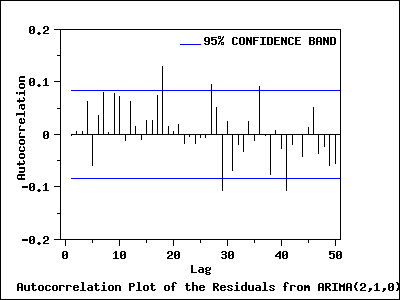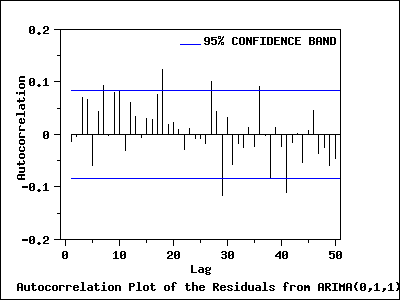6.
Process or Product Monitoring and Control
6.6.
Case Studies in Process Monitoring
6.6.2.
Aerosol Particle Size
6.6.2.4.
|
Model Validation
|
|
|
Residuals
|
After fitting the model, we should check whether the model is
appropriate.
As with standard
non-linear least squares
fitting, the primary tool for model diagnostic checking is residual
analysis.
|
|
4-Plot of Residuals from ARIMA(2,1,0) Model
|
The 4-plot
is a convenient graphical technique for model validation in that it tests
the assumptions for the residuals on a single graph.

|
|
Interpretation of the 4-Plot
|
We can make the following conclusions based on the above 4-plot.
- The run sequence
plot shows that the residuals do not violate the assumption
of constant location and scale. It also shows that most of the
residuals are in the range (-1, 1).
- The lag plot
indicates that the residuals are not autocorrelated at lag 1.
- The histogram and
normal probability
plot indicate that the normal distribution provides an
adequate fit for this model.
|
|
Autocorrelation Plot of Residuals from ARIMA(2,1,0) Model
|
In addition, the
autocorrelation plot
of the residuals from the ARIMA(2,1,0) model was generated.

|
|
Interpretation of the Autocorrelation Plot
|
The autocorrelation plot shows that for the first 25 lags, all sample
autocorrelations except those at lags 7 and 18 fall inside the 95 %
confidence bounds indicating the residuals appear to be random.
|
|
Test the Randomness of Residuals From the ARIMA(2,1,0) Model Fit
|
We apply the Box-Ljung test
to the residuals from the ARIMA(2,1,0) model fit to determine whether
residuals are random. In this example, the Box-Ljung test shows that
the first 24 lag autocorrelations among the residuals are zero
(p-value = 0.080), indicating that the residuals are random and
that the model provides an adequate fit to the data.
|
|
4-Plot of Residuals from ARIMA(0,1,1) Model
|
The 4-plot
is a convenient graphical technique for model validation in that it tests
the assumptions for the residuals on a single graph.

|
|
Interpretation of the 4-Plot from the ARIMA(0,1,1) Model
|
We can make the following conclusions based on the above 4-plot.
- The run sequence
plot shows that the residuals do not violate the assumption
of constant location and scale. It also shows that most of the
residuals are in the range (-1, 1).
- The lag plot
indicates that the residuals are not autocorrelated at lag 1.
- The histogram and
normal probability
plot indicate that the normal distribution provides an
adequate fit for this model.
This 4-plot of the residuals indicates that the fitted model is
adequate for the data.
|
|
Autocorrelation Plot of Residuals from ARIMA(0,1,1) Model
|
The autocorrelation plot of the residuals from ARIMA(0,1,1) was
generated.

|
|
Interpretation of the Autocorrelation Plot
|
Similar to the result for the ARIMA(2,1,0) model, it shows
that for the first 25 lags, all sample autocorrelations expect those
at lags 7 and 18 fall inside the 95% confidence bounds indicating
the residuals appear to be random.
|
|
Test the Randomness of Residuals From the ARIMA(0,1,1) Model Fit
|
The Box-Ljung test is also applied to the residuals from the
ARIMA(0,1,1) model. The test indicates that there is at least one
non-zero autocorrelation amont the first 24 lags. We conclude that there
is not enough evidence to claim that the residuals are random
(p-value = 0.026).
|
|
Summary
|
Overall, the ARIMA(0,1,1) is an adequate model. However, the ARIMA(2,1,0)
is a little better than the ARIMA(0,1,1).
|





